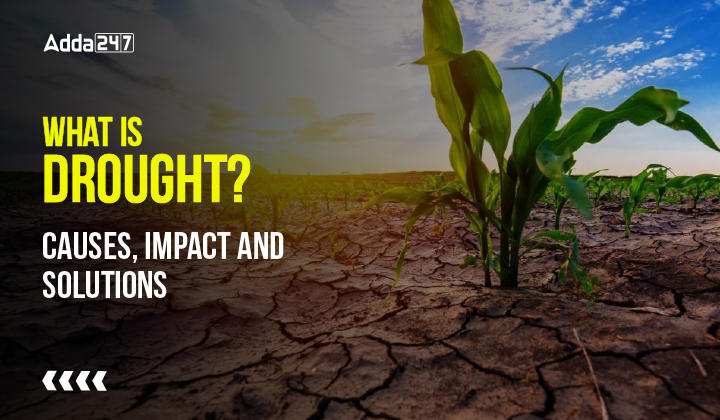Table of Contents
Global warming is a catastrophic calamity happening around the globe. This is not only damaging the non-living as well as living elements of the atmosphere. This is the root cause of different environmental threats. One of the outcomes of global warming is droughts. Droughts have been a tenacious issue in the past times but now this problem has become more aggravated. Let’s discuss the drought, its causes, impacts and solution to deal with the problem.
What is Drought?
As per the United States Geological Survey (USGS) drought is a tenure of drier-than-normal conditions that creates water-related problems. The condition where there is a lack of precipitation, such as rain, snow, or sleet, for an extended period, resulting in a water shortage. This lack of precipitation results in the death of plants and animals, stream flow declines, and water levels in lakes and reservoirs plunge. This persistent dry weather is called drought, which is a natural disaster. This is a silent threat because it can’t be predicted in advance.
Drought History
There have been several incidents in the past that indicate how badly this disaster has impacted the whole world. If we consider India there has been 18 meteorological and 16 hydrological droughts occurring in India in the time span of 1870 to 2018. The drought of 1899 can be classified as meteorological as well as hydrological and was the most severe documented drought India has ever experienced to date.
Whether droughts only represent 15% of natural disasters, they took the most extensive human toll, killing about 6,50,000 people between 1970 and 2019.
Types of Droughts
Droughts can be categorised into the following categories:
- Meteorological droughts: these droughts occur when there are long gaps in normal rainfall. These are gauged based on the degree of dryness and the period for which the dry period continues.
- Agricultural droughts: They occur when there is a deficiency of soil moisture to meet the needs of a crop at a particular time. They usually follow meteorological drought and emerge before a hydrological drought. Agricultural drought can be reckoned through indicators such as lack of rainfall, soil water deficits, reduced groundwater or reservoir levels etc.
- Hydrological droughts: These are the result of scarcity taking place in surface and subsurface water supplies like streams, rivers and lakes. The frequency and severity of hydrological droughts are measured at the watershed or river basin scale. This type of drought is influenced by reasons like land degradation or land use changes, construction of dams etc.
- Socioeconomic droughts: They occur when water shortages begin to affect people’s lives in a holistic manner.
Causes of Droughts
The causes of droughts are classified into two categories, natural causes and man-made causes. These are discussed in detail below:
Natural causes of drought
- Changes in ocean temperatures: Droughts in some parts of the world are caused by El Niño and La Niña are climate patterns El Niño is characterized by warmer-than-average ocean temperatures in the Pacific Ocean. This rise in temperature can lead to drought in the southwestern United States and southern Africa. Cooler-than-average ocean temperatures in the Pacific Ocean termed La Niña lead to drought in Australia and Indonesia.
- The jet stream: A band of strong winds that flows high in the atmosphere is termed the jet stream. Changes in the jet stream can lead to drought in some areas by bringing in dry air from other parts of the world.
Human causes of drought
- Change in Climate: Global warming is the leading cause of extreme weather conditions. It results in excess evaporation leading to an enhanced drier atmosphere and land crust.
- Deforestation: Plants and trees grasp and release water into the atmosphere, which forms clouds and then rain. There is a close relationship between deforestation and drought.
- Agriculture: Intensive agriculture contributes to deforestation in the first instance but can also affect the capacity of absorbing water and minerals from the soil.
- High water consumption: over usage of water resources made the situation worse. This is also the major reason behind calamities like drought.
Impact of drought
Droughts have impacted different domains of life. These are:
- Environmental effects: Major environmental effects that are caused by droughts are lower surface water, lower flow levels, the drying out of wetlands, increased pollution of surface water, forest fires and loss of biodiversity etc.
- Economic losses: They include economic and financial impacts on agricultural, forest and fishing output etc. Droughts ultimately lead to higher food production costs, and lower energy production because of reduced water levels in hydro plants. Hence, droughts lead to different economically harming situations for the country facing them.
- Social costs: this includes the negative impact on the health of people. Droughts result in lower water supply, increased pollution levels, and high food costs and ultimately enhance the social cost.
Droughts Solutions
Whether the early prediction of drought is not possible like other calamities like flood, tsunamis and others, hence there is no way out to reduce the impact after the event happen. The quote ‘prevention is better than cures’ typically suits here. So, there is a need to take the following steps to prevent and reduce the chances of this dreadful event happening:
- Rainwater harvesting is an easy solution to droughts. Ideas like sponge cities and house water harvesting can be of great help.
- Planting more trees will enhance the quality of the environment and boost the success of precipitation.
- Switch towards renewable sources of energy like wind and solar, which have little to no effect on the environment and will not result in droughts
- Stringent laws must be implemented on those who use practices that can cause droughts or other environmentally damaging results.
Conclusion
Hence, drought is a calamity that affects the world in the most dreadful ways. With increased global warming levels the problem has become grave and frequent in occurrence. There is a need to make ourselves aware of our actions that are causing harm to the environment. It is a need of an hour that we should collectively make efforts to reduce the pollution levels in order to prevent such happenings in the coming time.
CTET EVS Study Notes PDF
CTET Paper 1 EVS Study Notes PDF on “Drought” is a valuable study resource for candidates preparing for the CTET exam 2023. We encourage candidates to download and utilize this comprehensive CTET EVS Study Note PDF to enhance their exam preparation. The direct link to download is provided below for easy access to the simplified access to CTET Paper 1 EVS Study Notes PDF.




 MP TET Varg 3 Notification 2025 Out, Che...
MP TET Varg 3 Notification 2025 Out, Che...
 CG Vyapam Pre Deled Final Answer Key 202...
CG Vyapam Pre Deled Final Answer Key 202...
 CG Vyapam Pre DElEd Result 2025 Out, Dir...
CG Vyapam Pre DElEd Result 2025 Out, Dir...




